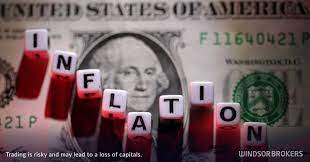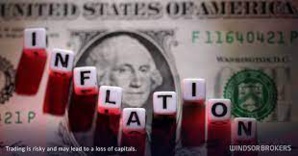Although January saw an increase in U.S. prices, the yearly gain in inflation was the lowest in over three years, meaning that the Federal Reserve's June interest rate cut remains on the table.
The Bureau of Economic Analysis of the Commerce Department reported on Thursday that the price index for personal consumption expenditures (PCEs) increased by 0.3% in the previous month. Data for December was reclassified to reflect a 0.1% growth in the PCE price index, as opposed to the 0.2% originally stated.
Up 2.4% in the year ending in January was PCE inflation. That came after a 2.6% gain in December and was the lowest year-over-year growth since February 2021.
According to Reuters polled economists, the PCE price index was expected to rise 0.3% month over month and 2.4% year. The rise in costs for consumers and producers last month, which most analysts attributed to companies hiking prices at the beginning of the year, was mirrored by the increase in prices this month.
Economists have contended that the government's approach, which eliminates seasonal variations from the data, most likely does not account for price increases at the start of the year. Most people don't think the price rises will happen again in February.
"It will be prudent to hold back on passing any strong judgment till February data comes out next month, if January's acceleration is a one-off that was perhaps due to the failure of seasonal adjustment factors to incorporate the true extent of firms raising prices at the start of the year, or whether it's the beginning of something more worrisome for the Fed," said Satyam Panday, chief U.S. economist at S&P Global Ratings.
After growing by a downwardly revised 0.1% in December, the PCE price index grew by 0.4% last month when the volatile food and energy components were excluded.
It was previously reported that the so-called core PCE price index increased by 0.2% in December.
Following a 2.9% increase in December, core inflation grew 2.8% year over year in January, the least amount since March 2021. In order to reach its 2% inflation target, the Fed monitors PCE pricing indicators. Over time, monthly inflation readings of 0.2% are required to return inflation to target.
The fourth-quarter inflation rate was slightly revised upward, according to government figures released on Wednesday. The financial markets have reduced their anticipation of a rate cut from May to June.
Fed representatives have stated that they will not be starting to decrease lowering rates.
The U.S. central bank has increased its policy rate by 525 basis points since March 2022, bringing it to the current range of 5.25%–5.50%.
Inflation increased last month even though consumer spending shrank. Over two-thirds of all economic activity in the United States is accounted for by consumer expenditure, which increased by 0.2% in December and 0.7% in January. The labour market is still tight, which supports spending and keeps wage increases high.
Initial claims for state unemployment benefits increased 13,000 to a seasonally adjusted 215,000 for the week ending February 24, according to a separate report released by the Labour Department on Thursday. For the most recent week, 210,000 claims were anticipated by economists.
Despite well-publicized layoffs at the beginning of the year, claims are lingering at historically low levels.
(Sourec:www.usnews.com)
The Bureau of Economic Analysis of the Commerce Department reported on Thursday that the price index for personal consumption expenditures (PCEs) increased by 0.3% in the previous month. Data for December was reclassified to reflect a 0.1% growth in the PCE price index, as opposed to the 0.2% originally stated.
Up 2.4% in the year ending in January was PCE inflation. That came after a 2.6% gain in December and was the lowest year-over-year growth since February 2021.
According to Reuters polled economists, the PCE price index was expected to rise 0.3% month over month and 2.4% year. The rise in costs for consumers and producers last month, which most analysts attributed to companies hiking prices at the beginning of the year, was mirrored by the increase in prices this month.
Economists have contended that the government's approach, which eliminates seasonal variations from the data, most likely does not account for price increases at the start of the year. Most people don't think the price rises will happen again in February.
"It will be prudent to hold back on passing any strong judgment till February data comes out next month, if January's acceleration is a one-off that was perhaps due to the failure of seasonal adjustment factors to incorporate the true extent of firms raising prices at the start of the year, or whether it's the beginning of something more worrisome for the Fed," said Satyam Panday, chief U.S. economist at S&P Global Ratings.
After growing by a downwardly revised 0.1% in December, the PCE price index grew by 0.4% last month when the volatile food and energy components were excluded.
It was previously reported that the so-called core PCE price index increased by 0.2% in December.
Following a 2.9% increase in December, core inflation grew 2.8% year over year in January, the least amount since March 2021. In order to reach its 2% inflation target, the Fed monitors PCE pricing indicators. Over time, monthly inflation readings of 0.2% are required to return inflation to target.
The fourth-quarter inflation rate was slightly revised upward, according to government figures released on Wednesday. The financial markets have reduced their anticipation of a rate cut from May to June.
Fed representatives have stated that they will not be starting to decrease lowering rates.
The U.S. central bank has increased its policy rate by 525 basis points since March 2022, bringing it to the current range of 5.25%–5.50%.
Inflation increased last month even though consumer spending shrank. Over two-thirds of all economic activity in the United States is accounted for by consumer expenditure, which increased by 0.2% in December and 0.7% in January. The labour market is still tight, which supports spending and keeps wage increases high.
Initial claims for state unemployment benefits increased 13,000 to a seasonally adjusted 215,000 for the week ending February 24, according to a separate report released by the Labour Department on Thursday. For the most recent week, 210,000 claims were anticipated by economists.
Despite well-publicized layoffs at the beginning of the year, claims are lingering at historically low levels.
(Sourec:www.usnews.com)






